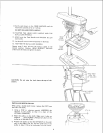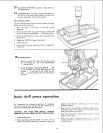
basic drill press
operation
INSTALLING DRILLS
Insert drill into chuck far enough to obtain maximum
GRIPPING of the CHUCK JAWS ... the jaws are appox. 1
in. long. When using a small drill do not insert it so far that
the jaws touch the flutes (spiral grooves) of the drill.
Make sure that the drill is CENTERED in the chuck before
tightening the chuck with the key.
Tighten the drill sufficiently, so that it does not SLIP while
drilling.
POSITIONING TABLE AND WORKPIECE
Lock the table to the column in a position so that the tip of
the drill is just a little above the top of the workpiece. It is
not necessary to reposition the TABLE SUPPORT
COLLAR each time you reposition the table. Always keep
the collar locked about 34 in. from the floor.
Always place a piece of BACK-UP MATERIAL (wood,
plywood ...) on the table underneath the workpiece. This
will prevent "splintering" or making a heavy burr on the
underside of the workpiece as the drill breaks through.
Position workpiece to butt against the column whenever
possible - if it is too short, clamp solidly to the Table -
this is to prevent the drill bit from grabbing the work from
your hands, which could result in personal injury. A drill
press vise must be fastened to the table.
CAUTION: To prevent the workpiece or the back-up
material from being torn from your hand while drilling,
position them against the left side of the column. Failure to
do this could result in personal injury.
CAUTION: If the workpiece or the back-up material are
not long enough to reach the column, CLAMP them to the
QUILLHANLO _
VCORKPIECE
table. Failure to do this could result in personal injury.
For small pieces that cannot be clamped to the table, use a WORKPIECE
drill press vise (Optional accessory), The vise must be "\
clamped or bolted to the table. \
DRILL PRESS
VISE
HOLE LOCATION
Make a DENT in the workpiece where you want the hole
... using a CENTER PUNCH or a SHARP NAI L.
Before turning the switch ON, bring the drill down to the
workpiece lining it up with the hole location.
FEEDING
allow the drill to cut.
Feeding TOO SLOWLY might cause the drill to burn ..,
Feeding TOO RAPIDLY might stop the motor .., cause
the belt or drill to SLIP ... tear the workpiece LOOSE
from your hand or BREAK the drill bit.
When drilling metal use Sears Thread-cutting oil
Pull down on the feed handles with only enough effort to
16


















